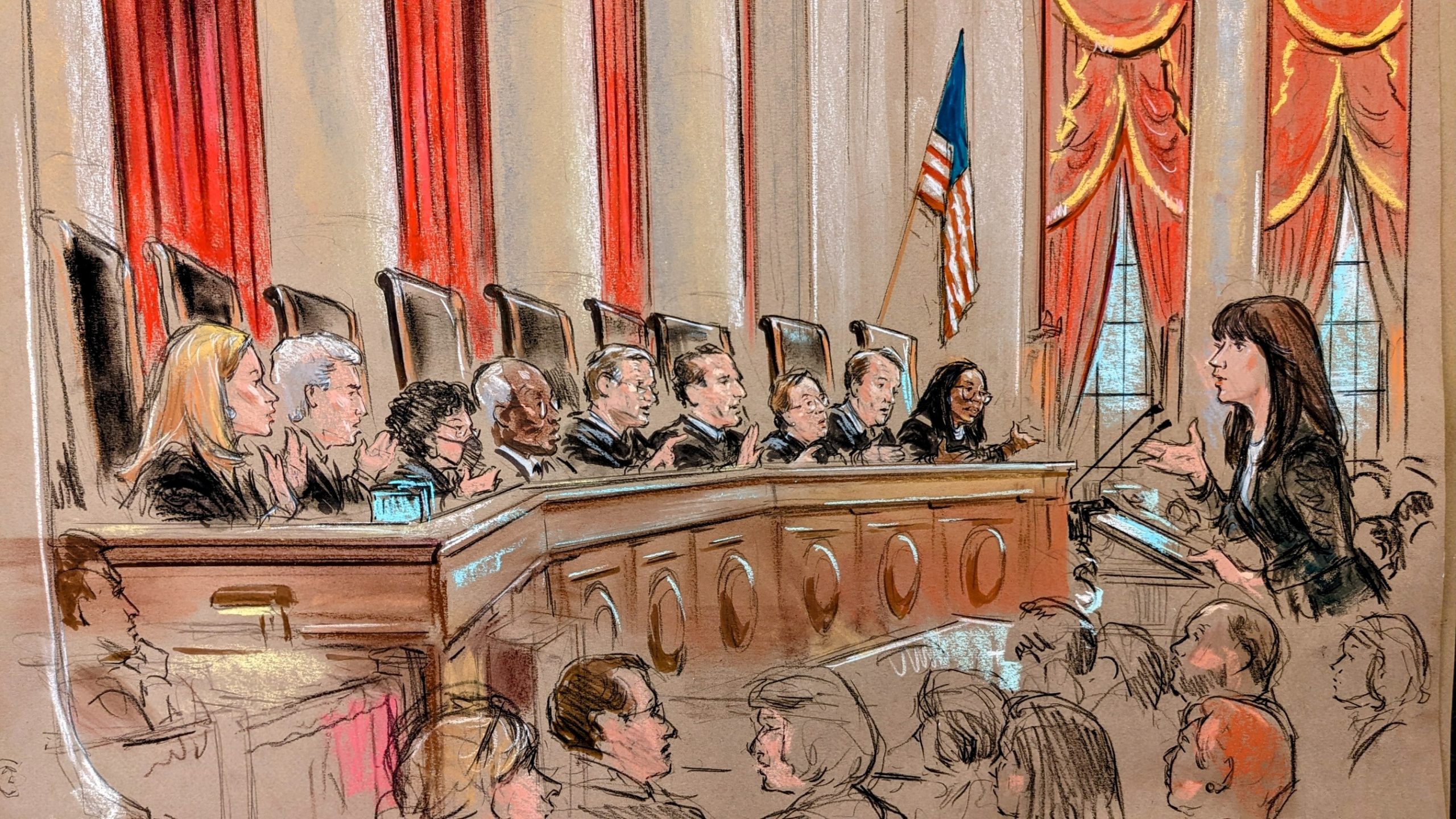ARGUMENT ANALYSIS
on Nov 29, 2022
at 4:55 pm

U.S. Solicitor General Elizabeth Prelogar argues for the federal government. (William Hennessy)
The Supreme Court heard oral argument on Tuesday in a challenge to a Biden administration policy that prioritizes certain groups of unauthorized immigrants for arrest and deportation. Although some justices questioned the legality of the policy, there were also questions about whether the states challenging the policy could bring their lawsuit at all, and whether a federal district judge had the power to set aside the policy. After nearly two-and-a-half hours of debate, it was difficult to predict precisely how the justices will resolve the case, which could have significant implications not only for the the executive branch’s ability to set immigration policy but also for states’ ability to sue the federal government when they disagree with its actions.
The policy at the center of the case is set forth in a September 2021 memorandum by Secretary of Homeland Security Alejandro Mayorkas. The memorandum explains that because the Department of Homeland Security does not have the resources to apprehend and deport all of the more than 11 million noncitizens who could be subject to deportation, immigration officials should prioritize the apprehension and deportation of three groups of noncitizens: suspected terrorists, people who have committed crimes, and those caught recently at the border.
Texas and Louisiana went to federal court in Texas to challenge the policy. U.S. District Judge Drew Tipton agreed with the states that the policy violates federal law and vacated it nationwide.
When the Supreme Court decided to take up the case, it directed the parties to address three questions. The first was whether the states had a legal right to bring their lawsuit – a concept known as standing. Texas Solicitor General Judd Stone told the justices on Tuesday that the states have standing because of the costs that the policy inflicts on them, for everything from social services to incarceration for noncitizens who commit new crimes.

Judd Stone, solicitor general of Texas, argues for the state. (William Hennessy)
Justice Ketanji Brown Jackson suggested that any harm that the states suffered was the result of decisions they made, rather than the policy itself. If the federal government has decided not to detain some noncitizens with a criminal history because it doesn’t believe that they are a risk, she said, but Texas nonetheless opts to detain them, Texas has chosen to incur a self-inflicted injury.
Justice Elena Kagan was perhaps the strongest proponent of the idea that the states do not have standing. She told Stone that, under his theory, states could challenge virtually all immigration policies – “not to mention all the other policies in the world†– even if they cost the states only one dollar. Immigration policy, she said, is supposed to be the “zenith†of federal power, but instead Stone’s theory would allow states to bring immigration policy to a “dead halt.â€
U.S. Solicitor General Elizabeth Prelogar, representing the Biden administration, echoed Kagan’s sentiments. She too stressed the “consequences of the district court’s very broad†conception of standing: Any state can challenge any decision by the federal government, and if it can persuade just one federal district judge, he can issue an order blocking the policy nationwide. That in turn, she reminded the justices, will lead the federal government to come to the Supreme Court, asking it to intervene on an emergency basis – without oral argument or the benefit of several decisions by the lower courts exploring the question. Such a process, she said, is “bad for the executive branch,†“bad for the American public,†and “bad for†federal courts.
Chief Justice John Roberts pressed Prelogar to clarify the scope of the Biden administration’s rule. Under that rule, he asked, states would never have standing to challenge immigration enforcement? When Prelogar responded that they would not, Roberts reminded her of the court’s recent decision in Biden v. Texas, in which Texas and Missouri challenged the Biden administration’s decision to end the Trump administration’s controversial “remain in Mexico†policy. “I would have thought you’d have a little more concern about an opinion of ours that is four months old,†Roberts admonished Prelogar.
Justice Samuel Alito also was skeptical about the Biden administration’s rule. When Prelogar suggested that an indirect injury could be the basis for standing for other plaintiffs, but not for the states, Alito characterized that suggestion as “a rule of special hostility†to states.
Justice Brett Kavanaugh also seemed inclined to hold that the states would have standing to challenge the policy. He peppered Prelogar with a series of questions about whether, in the government’s view, anyone could challenge the decision by a new presidential administration not to enforce labor or environmental laws that were already on the books. When Prelogar answered that no one could challenge those decisions in court, but that the administration could still face political pushback, Kavanaugh was unconvinced. Congress enacted the federal immigration laws at the center of this case, he told Prelogar, because the existing laws were not being enforced. It would be nonsensical, he suggested, if no one had standing to challenge the laws.
The second question before the court focused on the federal immigration laws themselves, and whether they require the federal government to detain noncitizens who have committed certain crimes after their release from prison and to keep in custody noncitizens who are subject to final deportation orders. The justices spent relatively little time on this question, but here too they were divided. Alito saw one problem with the Biden administration’s policy: Although Congress outlined its own priorities for federal immigration law, including a requirement to detain noncitizens who have been convicted of serious crimes, the policy does not follow those priorities. Instead, he said, it directs immigration officials to make a case-by-case determination whether someone with a criminal history should be detained.
Roberts attempted to grapple with the problem at the center of the policy: The government’s inability to apprehend, detain, and deport all of the 11 million noncitizens in the United States who could be subject to deportation. He told Prelogar, on the one hand, that Congress’ use of the word “shall†in the immigration laws at issue in this case imposes a mandatory duty to detain or deport the noncitizens covered by the law. “It’s our job to say what the law is,†Roberts insisted, and then “Congress and the executive branch need to figure out a way to comply.â€
But Roberts took a different tack with Stone, telling him that “it is impossible†for the executive branch to comply with federal immigration laws in the way that the states would require. If we think it would be very difficult to enforce the law as you interpret it, Roberts asked, shouldn’t we consider that difficulty in deciding whether “shall†actually means “shall�
Kavanaugh echoed Roberts’ concerns about the feasibility of the states’ argument. “If you prevail here,†he asked Stone, “what will happen?†Kavanaugh suggested that, because of the lack of resources, he was “not sure much will change.â€
Stone pushed back, countering that the Department of Homeland Security is not currently using all of the resources that it has available to detain and deport noncitizens. But during her rebuttal, Prelogar reiterated that “it is impossible for DHS to comply†with the requirements that the states would have the court impose. If immigration officials have no discretion in enforcing the law, she cautioned, they will have to take all deportable noncitizens whom they find into custody, which will in turn use up the resources that should be targeted at real security threats. It’s a “senseless way to run an immigration system,†Prelogar concluded.
The third question before the justices was whether Tipton had the power to block the Biden administration from implementing the policy nationwide. Stone pointed to the federal law governing administrative agencies, arguing that it clearly gives courts the power to “set aside†agency actions that do not comply with federal law.
Prelogar, on the other hand, told the justices that the provision authorizing courts to “set aside†agency actions only allows courts to disregard the policy in the case before them; it does not give the district court the power to invalidate the policy altogether. That argument met with strong resistance from three justices who came to the Supreme Court from the U.S. Court of Appeals for the District of Columbia Circuit, which frequently fields challenges to agency action.
Roberts, who spent just over two years on the D.C. Circuit, told Prelogar that the Biden administration’s position on this point was “very radical.†On the D.C. Circuit, he joked, judges often vacated agency action “five times before breakfast.†When Prelogar countered that the lower courts had misinterpreted the statute, Roberts let out a surprised “wow.â€
Kavanaugh, who spent (as he noted) 12 years on the D.C. Circuit, strongly resisted Prelogar’s suggestion that lower courts had overlooked the text or history of federal administrative law. Kavanaugh pointed to several well-respected judges, both conservative and liberal, with whom he worked on the D.C. Circuit, telling Prelogar that those judges “paid a lot of attention†to the text and history of the law. Like Roberts, Kavanaugh stressed that the government’s position would be a “pretty radical rewrite†of current law. “Set aside†means to “set aside†something, Kavanaugh said, so that the rule is no longer in place.
Jackson, who spent just over a year on the D.C. Circuit, sided with Roberts and Kavanaugh. She told Prelogar that she saw a “conceptual problem†with the administration’s argument. A claim under federal administrative law, she explained, would be based on the contention that the federal agency has failed to follow the proper procedures. It would be a “disconnect to say,†she told Prelogar, that if a court agreed with a challenger that the agency had not followed proper procedures in adopting a rule, the rule wouldn’t apply to the challenger but the agency could still apply that rule to others.
But other justices were more receptive to the government’s position. Justice Neil Gorsuch suggested that vacating the policy was essentially the same thing as an injunction barred by federal immigration law. Either way, he said, the government will enforce federal immigration laws differently. Gorsuch also noted that the provision allowing courts to “set aside†agency action appears in a statute governing the scope of review for federal courts, rather than the provision governing remedies. If a federal court has the power to invalidate agency action under the “set aside†provision, he posited, it would be a “monster swallowing all of the other remedies.â€
And Alito complained that although the question raised by the Biden administration appeared to him to “be a pretty big issue,†the administration and the states had only addressed it in a few pages in their briefs in the Supreme Court. How, Alito queried, should the court determine which interpretation is the correct one?Â
Alito’s question seemed to raise at least the possibility that the court could call for more briefing on the third question in the case. Either way, a decision is expected sometime next year.
This article was originally published at Howe on the Court.





